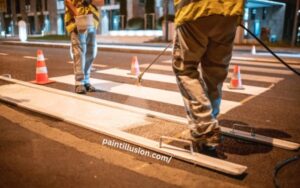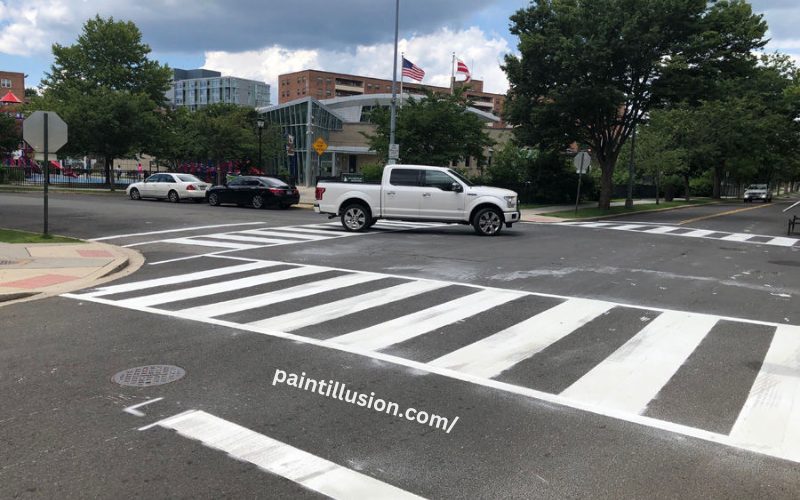Non-reflective paint, also known as matte paint, is a type of paint that does not produce a shiny or reflective surface. It is specifically designed to minimize light reflection, making it ideal for various applications where glare or reflection is unwanted. Non-reflective paint is commonly used in photography studios, art galleries, theaters, and even in crossword puzzles.
The main characteristic of non-reflective paint is its ability to absorb light rather than reflect it. This is achieved through the use of special pigments that scatter and absorb light particles, resulting in a flat, muted finish. Unlike glossy or satin paints, non-reflective paint creates a smooth and velvety appearance that adds a touch of elegance to any surface.
Advantages of using non-reflective paint
There are several advantages to using non-reflective paint in your projects. First and foremost, it eliminates glare and reflections, which can be especially beneficial in areas with bright lighting or where visual distractions need to be minimized. Non-reflective paint is also great for hiding imperfections on surfaces, as its matte finish tends to camouflage minor flaws such as scratches or dents.
Additionally, non-reflective paint is often easier to touch up and maintain compared to glossy or satin finishes. Its porous nature allows for better adhesion of touch-up paint, ensuring seamless repairs. Furthermore, non-reflective paint is less likely to show fingerprints or smudges, making it a practical choice for high-traffic areas or surfaces that are frequently touched.
Different types of non-reflective paint available
There are various types of non-reflective paint available on the market, each with its own unique characteristics and applications. Here are a few examples:
Acrylic non-reflective paint
Acrylic non-reflective paint is a popular choice among artists and crafters due to its versatility and ease of use. It dries quickly, has good color retention, and can be applied to a wide range of surfaces, including canvas, wood, metal, and more. Acrylic non-reflective paint is available in both opaque and transparent formulations, allowing for different levels of coverage and effects.
Latex non-reflective paint
Latex non-reflective paint is commonly used for interior walls and ceilings. It is water-based, which means it is easy to clean up with soap and water. Latex non-reflective paint is also known for its quick drying time and low odor, making it a convenient choice for indoor projects. It comes in a variety of colors and finishes, allowing you to achieve the desired look for your space.
Chalkboard paint
Chalkboard paint is a type of non-reflective paint that is specifically designed for creating writeable surfaces. It can be applied to walls, furniture, and other smooth surfaces, turning them into functional chalkboards. Chalkboard paint is available in both traditional black and a variety of colors, allowing for creative and customizable designs. It is a great option for classrooms, offices, or even for adding a unique touch to home decor.

How to choose the right non-reflective paint for your needs
When choosing non-reflective paint, it’s important to consider your specific needs and the requirements of your project. Here are a few factors to keep in mind:
Surface type
Consider the surface that you will be painting on. Different non-reflective paint formulations are designed for specific surfaces, such as walls, furniture, or outdoor applications. Make sure to choose a paint that is suitable for the surface you will be working with to ensure proper adhesion and longevity.
Finish
Non-reflective paint comes in various finishes, including flat, matte, and eggshell. The finish you choose will depend on your personal preference and the look you want to achieve. Flat and matte finishes provide a more muted appearance, while eggshell finishes offer a slight sheen. Consider the overall aesthetic of your space and choose a finish that complements it.
Durability
If you will be painting a high-traffic area or a surface that is exposed to the elements, durability is an important factor to consider. Look for non-reflective paint that is specifically formulated for durability, such as exterior-grade paint or paint with added protective coatings. This will ensure that your paint job stays looking fresh and lasts longer.
Application tips for non-reflective paint
To achieve the best results with non-reflective paint, here are some application tips to keep in mind:
Surface preparation
Proper surface preparation is crucial for a successful paint job. Make sure to clean the surface thoroughly, removing any dirt, grease, or loose paint. Sanding the surface lightly can also help ensure better adhesion of the paint. Additionally, consider using a primer designed for non-reflective paint to enhance adhesion and coverage.
Use the right tools
Choose the right tools for the job to ensure a smooth and even application. For larger surfaces, a roller is often the most efficient choice, while brushes are great for smaller areas and details. Make sure to use high-quality brushes and rollers to achieve the best results. If necessary, apply multiple coats of paint, allowing each coat to dry completely before applying the next.
Proper ventilation
When working with non-reflective paint, it’s important to ensure proper ventilation in the painting area. Open windows or use fans to circulate fresh air and prevent the buildup of fumes. If painting indoors, consider using a low VOC (volatile organic compounds) or no VOC paint to minimize the release of harmful chemicals.
Common uses for non-reflective paint
Non-reflective paint has a wide range of applications due to its unique properties. Here are some common uses for non-reflective paint:
Photography and art studios
Non-reflective paint is widely used in photography and art studios to create a neutral background that does not interfere with the subject or artwork. Its matte finish helps eliminate glare and reflections, allowing for more accurate color representation and better overall image quality.
Theaters and performance spaces
In theaters and performance spaces, non-reflective paint is often used on stage floors, walls, and backdrops. It helps minimize unwanted reflections from stage lighting, ensuring a clear and focused performance for the audience.
Crossword puzzles
Non-reflective paint is also used in crossword puzzles to create black squares. These black squares help separate the white spaces and provide a visual clue for the solver. The matte finish of non-reflective paint ensures that the black squares do not create glare or reflections that may distract from the puzzle-solving experience.
Where to buy non-reflective paint
Non-reflective paint can be purchased from various sources, including paint stores, home improvement centers, and online retailers. Here are a few options to consider:
Paint stores
Visit your local paint store to find a wide selection of non-reflective paint options. Paint store staff can often provide expert advice and help you choose the right product for your needs. Additionally, they may have color-matching services available to ensure you get the perfect shade for your project.
Home improvement centers
Home improvement centers often have a dedicated paint department where you can find non-reflective paint. They typically carry a range of brands and finishes, allowing you to compare options and choose the best one for your project. Home improvement centers may also offer additional resources, such as paint mixing services or DIY workshops.
Online retailers
If you prefer the convenience of online shopping, many retailers offer non-reflective paint for purchase on their websites. Online retailers often provide detailed product descriptions, customer reviews, and color swatches to help you make an informed decision. Keep in mind that shipping times and costs may vary depending on your location.
How to use non-reflective paint in crossword puzzles
Using non-reflective paint in crossword puzzles is a straightforward process. Here’s how you can incorporate it into your puzzle-making:
1. Start with a grid
Begin by creating a crossword grid using a pencil and graph paper. The grid should have rows and columns with black squares strategically placed to separate the white spaces. Consider the overall size and difficulty of the puzzle when determining the number and placement of black squares.
2. Fill in the black squares
Once you have the grid layout finalized, use non-reflective paint to fill in the black squares. Apply the paint carefully using a small brush or a fine-tip marker to ensure clean lines and a uniform appearance. Allow the paint to dry completely before moving on to the next step.
3. Add the clues and answers
After the non-reflective paint has dried, use a pen or marker to add the clues and answers to the puzzle. Write the clues in the corresponding squares, making sure they align with the black squares and the overall layout of the puzzle. Fill in the answers in the white spaces, ensuring they are placed correctly and fit within the grid.
4. Test and refine
Before finalizing your crossword puzzle, it’s important to test it for accuracy and solvability. Solve the puzzle yourself or ask others to try it out and provide feedback. Make any necessary adjustments to the clues, answers, or overall layout to ensure a challenging yet solvable puzzle.
Other uses for non-reflective paint
In addition to its common applications, non-reflective paint has other creative uses as well. Here are a few examples:
DIY projects
Non-reflective paint can be used in various DIY projects to add a unique touch to furniture, decor items, or even clothing. Consider using non-reflective paint to create a distressed or weathered look on wooden furniture, or to add custom designs to canvas shoes or tote bags.
Automotive customization
Non-reflective paint is also popular among automotive enthusiasts for customizing vehicles. It can be used to create a matte or satin finish on car exteriors, giving them a sleek and modern appearance. Non-reflective paint can also be used on interior trim pieces or accessories to add a touch of personalization.
Architectural design
In architectural design, non-reflective paint is often used to create a contemporary and minimalist look. It can be applied to walls, ceilings, or even entire buildings to achieve a sleek, matte finish. Non-reflective paint can also be used to highlight specific architectural features or create a contrast with other finishes.
Conclusion
Non-reflective paint offers a range of benefits and applications. Its ability to eliminate glare and reflections makes it a valuable tool for photographers, artists, and crossword puzzle enthusiasts alike. With various types and finishes available, choosing the right non-reflective paint for your needs is essential. Whether you’re looking to create a neutral background, hide imperfections, or add a unique touch to your DIY projects, non-reflective paint is a versatile and practical choice. So go ahead, explore the possibilities of non-reflective paint and unlock its creative potential in your next endeavor.
CTA: If you’re ready to experience the benefits of non-reflective paint, browse our selection of high-quality options at [insert link to online store]. Start your next project with confidence and enjoy the beauty of a matte finish.

